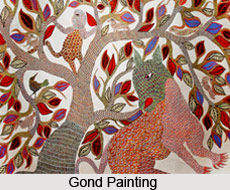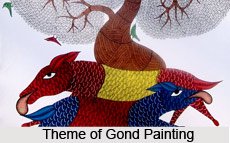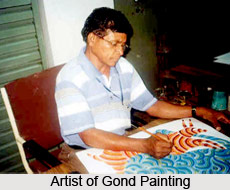 Gond paintings are contemporary art form which originated among the Gond tribal community of Central India. These paintings beautifully depict the life of this community and are characterized by customary tattoos and motifs. They are also believed to be associated with good fortune. Gond paintings are used by the tribal people to embellish the walls and floors of their homes. They exhibit varied attributes like flashy, simple or sophisticated. Each painting holds a specific interpretation.
Gond paintings are contemporary art form which originated among the Gond tribal community of Central India. These paintings beautifully depict the life of this community and are characterized by customary tattoos and motifs. They are also believed to be associated with good fortune. Gond paintings are used by the tribal people to embellish the walls and floors of their homes. They exhibit varied attributes like flashy, simple or sophisticated. Each painting holds a specific interpretation.
Origin of Gond Paintings
People of Gond tribe are mainly the residents of Madhya Pradesh and its adjoining states. During festivals and occasions, the floors and walls of the houses are exquisitely decorated with Gond painting using coloured mud. At the inception of this art, it was primarily used as a symbolic art to fight off the evil spirits. It was believed that at the time of Dighna festival, a significant occasion of Gond tribe, these paintings invite optimism. During 1980s the beliefs pertaining to these paintings underwent changes. A few artistic Pardhan Gonds, who were the bardic priests by profession and tradition, perceived it as a visual and figurative art. This led to the introduction of modern media for creating unique representations of songs, mythology, history and other worldly aspects through Gond paintings. The different media that came into use included animated film, ink on papers, silkscreen prints and acrylic paintings on canvases.
Jangarh Singh Shyam is credited as the first artist who used paper and canvas for this art. Initially he adopted traditional ways of painting but later explored other modern media too. He had a major contribution in this art form as throughout his life he aimed at spreading Gond painting in Patangarh, a village in Madhya Pradesh. His exhibitions across the globe earned him huge acclamations and popularized this art among several contemporary artists.
Style of Gond Paintings
Gond paintings are mainly characterized by dots, dashes and collages which combine to form vibrant images of plants and animals. Folklores are magnificently articulated through these paintings. These painting can be found in black and white combinations or in other flashy hues. Detail, mystery, humour and colour wondrously blend in these paintings. Both the themes and mediums of Gond paintings have undergone varied experimentations and innovations. Signature styles dominate these painting forming an alluring feature. These signature styles are usually employed for filling in the patterns and ornamental motifs.
Folklores are magnificently articulated through these paintings. These painting can be found in black and white combinations or in other flashy hues. Detail, mystery, humour and colour wondrously blend in these paintings. Both the themes and mediums of Gond paintings have undergone varied experimentations and innovations. Signature styles dominate these painting forming an alluring feature. These signature styles are usually employed for filling in the patterns and ornamental motifs.
Themes of Gond Paintings
Gond paintings find inspirations from various myths and legends as well as from daily quests of life. Imaginations and dreams also emote through them. Elaborate depiction of flora, fauna and mythological beasts are the dominant themes. Mother Nature can also be seen portrayed in Gond paintings through nature themes.
Techniques of Gond Paintings
Natural materials are used to make colours for Gond paintings such as white from rock calcium, black from local soils and yellow from Narmada River banks. Charcoal and lime serve as medium for the ornamental paintings especially in case of painting homes. The outline of the paintings uses black colour, after the drying of which the filling of the motifs is done. This augments the beauty of the paintings by imparting a three dimensional effect.
 Artists of Gond Paintings
Artists of Gond Paintings
Some of the prominent artists of Gond painting are Suresh Kumar Dhurwe, Bhajju Shyam, Jangarh Singh Shyam, Ram Singh Urveti, Narmada Prasad Tekam, Japani Shyam and Durga Bai.
Through their uniqueness and magnificence Gond paintings have acquired a special position in the global market. This international exposure has greatly changed the lives of tribal people. With this impact, this art has expanded its boundaries beyond the cultural arena and attained new heights in the world of arts. Not only on the painting canvases, Gond paintings has also marked their presence in contemporary artefacts like pen stands, key chains, mugs, mouse pads and many more.



















